http://www.paper.edu.cn
Lieb晶格中螺旋边界态的有限尺寸效应
陈锐,周斌
湖北大学物理与电子科学学院,武汉 430062
摘要:在本文,我们研究在Lieb晶格中螺旋边界态的有限尺寸效应,我们考虑了三种不同的边
界情况:直边界,胡须型边界和不对称边界。我们解析地得到了紧束缚模型下的Lieb晶格边界
模式的能谱和波函数。在直边界的条状Lieb模型中,本征自旋轨道耦合导致类狄拉克体态的波
函数局域到边界上,形成了具有同样类狄拉克能谱的螺旋边界态。在直边界情况,无能隙的类
狄拉克能谱随着材料的宽度减小保持不变,量子自旋霍尔态的有限尺寸效应没有出现。在另两
种情况下,随着条状样品宽度的减小,有限尺寸效应导致的能隙将被打开。
关键词:量子自旋霍尔效应;有限尺寸效应;自旋轨道耦合;拓扑绝缘体
中图分类号: O469
Finite size effects on the helical edge states on
the Lieb lattice
Chen Rui, Zhou Bin
Faculty of Physics and Electronic Technology, Hubei University, Wuhan 430062
Abstract: In this paper, we investigate the finite size effect of helical edge states on the Lieb
lattice with ISO coupling under three different kinds of boundary conditions, i.e., the straight,
bearded and asymmetry edges. The spectrum and wave function of edge modes are derived
analytically for a tight-binding model on the Lieb lattice. For a strip Lieb lattice with two
straight edges, the ISO coupling induces the Dirac-like bulk states to localize at the edges to
become the helical edge states with the same Dirac-like spectrum. Moreover, it is found that
in the case with two straight edges the gapless Dirac-like spectrum remains unchanged with
decreasing the width of the strip Lieb lattice, and no gap is opened in the edge band, that is,
finite size effect of QSH states is absent. However, in the other two cases with the bearded
and asymmetry edges, the energy gap induced by finite size effect is still opened with
decreasing the width of the strip.
Key words: quantum spin Hall state; finite size effect; spin-orbit coupling; topological
insulators
基金项目: National Natural Science Foundation of China (Grant No. 11274102), Program for New Century
Excellent Talents in University of Ministry of Education of China (Grant No. NCET-11-0960), and Specialized
Research Fund for the Doctoral Program of Higher Education of China (Grant No. 20134208110001).
作者简介: Rui Chen (1992-), male, postgraduate student, semiconductor spintronics. Corresponding Author:
Zhou Bin (1972-), male, professor, semiconductor spintronics. Email: binzhou@hubu.edu.cn
- 1 -
�
http://www.paper.edu.cn
0 Introduction
A two-dimensional Lieb lattice, [1] also called a line-centered square lattice, has attracted
considerable research interest due to the specific properties induced by its topology. Each unit
cell on the Lieb lattice contains three atoms (A, B, and C) (cf. Fig. 1(a)). On the other hand,
quantum spin Hall (QSH) effects, also called two-dimensional topological insulators, and three-
dimensional topological insulators have become immensely popular and active research fields
in the condensed matter physics community. [2, 3] When the intrinsic spin-orbit (ISO) coupling
is introduced to the Lieb lattice, a topologically nontrivial bulk gap is opened and it gives rise
to QSH effect characterized by two pairs of gapless helical edge states within the bulk gap. [4]
Recently, topological phase transitions driven by different parameters on the Lieb lattice have
also been furtherly investigated. [5–9] Noted that the finite size effect in topological insulators
was firstly proposed in QSH states of HgTe quantum well, due to the fact the edge states on
the two sides can couple together to produce a gap in the spectrum. [10] Later, the finite size
effect has also been predicted theoretically in three-dimensional topological insulator thin films.
[11–14] Moreover, the gap due to the finite size effect has been confirmed experimentally. [15, 16]
It is proposed that the role of the finite size effect in topological insulators should be considered
seriously in potential use of the topologically protected edge (surface) states in application on
the nanometer scale.
Fig 1: (Color online) Illustration of the Lieb lattice. (a) A two-dimensional Lieb lattice. (b),
(c) and (d) Scheme of the strip lattice with the straight, bearded and asymmetry edges.
In this paper, we focus on the influence of the different edge geometries of the strip Lieb
lattices on the finite size effect of helical edge state. Three kinds of edge geometries, i.e., straight,
bearded and asymmetry edges (cf. Fig. 1(b-d)), are investigated, respectively. Based on the
tight-binding model, the spectrum and wave function of edge modes are derived analytically.
- 2 -
xay(a)ABC(b)(d)(c)�
http://www.paper.edu.cn
1 The edge modes under semi-infinite boundary
conditions
In this section, we discuss the edge modes on the Lieb lattice with a semi-infinite geometry.
We start from the Hamiltonian of the tight-binding model for a two-dimensional Lieb lattice
with ISO coupling [4]
(1)
where the spin-independent nearest-neighbor (NN) hopping term H0 and ISO coupling term
Hso are given as follows, respectively,
H = H0 + Hso,
†
c
iσcjσ,
i,jσ
iσ(dk × dl) · σσσcjσ.
†
c
H0 = t
i,jσσ
Hso = iλ
(2)
(3)
iσ (ciσ) is the creation (annihilation) operator for a particle with spin σ (=↑, ↓) on site
†
Here, c
i of the Lieb lattice, t is the NN hopping amplitude, λ presents the amplitude of ISO coupling
induced by the spin-dependent next-nearest-neighbor (NNN) hopping (shown by the dashed
lines in Fig. 1), σ is the vector of Pauli spin matrices, dk and dl are the two displacement unit
vectors of the NNN hopping process connecting sites i and j.
1.1 The case with the straight edge
Firstly, we focus on the case of semi-infinite geometry with a straight edge. Here, we
mention that in the y-axis direction the half plane begins with the type A and B sites (see
the upper boundary in Fig. 1(b)). Here and hereafter, a periodic boundary condition along
the x-axis direction is considered. The corresponding Schr¨odinger equation for spin-up part is
given by
where
t†
a
εa
. . .
a
t†
. . .
ta
. . .
εa
. . .
εa
ta
−E
εa =
τ0
t
−E −τso
τ0
t −τso −E
ta =
φ1
φ2
...
φj
...
= 0,
0 0
0 0 τso
0 0
0
t
a
t†
. . .
,
- 3 -
(4)
(5)
,
�
http://www.paper.edu.cn
and φj =ψA
T
j , ψB
j , ψC
j
with τ0 = 2tcx and τso = 2λsx. Here we only consider the edge modes
and try an edge state solution with property: φj+1 = ρφj ≡ ρjφ with |ρ| < 1. Then Eq. (4)
can be reduced into the two equations as follows, an initial equation
(εa + ρt†
a)φ = 0,
ρj−2(ta + εaρ + t†
aρ2)φ = 0,
and the inner one
with j = 2, 3, ··· , ∞.
By solving Eqs. (6) and (7), one can get the energy spectrum of spin-up edge state
and the corresponding eigenstate
φs↑ =
Es↑(kx) = 2t cos(kx/2),
T
1, 1, 0
,
with
ρ =
τso − t
τso + t
.
(6)
(7)
(8)
(9)
(10)
It is indicated that the edge mode is composed only from orbitals of the type A and B of the
Lieb lattice with a straight edge.
1.2 The case with the bearded edge
Let us turn to the case of a different boundary geometry, the bearded edge geometry. In
the y-axis direction, the half plane begins with the C-type sites (see the upper boundary in Fig.
1(c)). Under the semi-infinite boundary condition, the corresponding Schr¨odinger equation for
εd
td
−E
spin-up part is given by
with
j =ψC
and φ
j , ψA
j , ψB
j
εd =
T
t
†
d
εd
. . .
†
t
d
. . .
td
t
τso
t −E τ0
τ0 −E
τso
= 0
, td =
†
t
d
. . .
. . .
εd
. . .
1
2
j
φ
φ
...
φ
...
0
,
t −τso
0
0
0 0
0 0
(11)
(12)
(13)
. We assume an edge state solution as follows
φ
j+1 = χφ
j ≡ χjφ,
- 4 -
�
edge modes with the energy bands
τsot
Eb↑±(kx) =
and the corresponding eigenstates
√
τ0±
τso
where ωA± =
φb↑± =
t
, ωB± =
0 +4t2
so − t2
τ 2
2(τ 2
so + t2)2
so+τ 2
4τ 2
so+t2)
2(τ 2
χ± =
,
so + τ 2
0 + 4t2
τ0 ±4τ 2
1, ωA±, ωB±
√
τ0±
τ 2
so + t2
T
0 +4t2
so + 2t2 ± τ0
so+τ 2
4τ 2
so+t2)
2(τ 2
,
, and
(16)
(17)
(18)
.
http://www.paper.edu.cn
with |χ| < 1. Substituting Eq. (13) into Eq. (11), one can get two equations as follows
(εd + χt
†
d)φ = 0,
†
dχ2)φ = 0.
χj−2(td + εdχ + t
(14)
(15)
By solving Eqs. (14) and (15), one finds that for spin-up part there are two branches of
τ 2
0 + 2τ 2
4τ 2
so + τ 2
0 + 4t2
Two branches of edge modes Eb↑± given by Eq. (16) are plotted in blue and red dashed lines,
respectively, in Fig. 2(a). Different from the case of the straight edge, the edge mode with the
bearded edge is composed from orbitals of the type A, B and C of the Lieb lattice.
Fig 2: (Color online) Band structure and the parameters χ± varies with kx.
spectrum for spin-up part with λ = 0.6t under bearded boundary condition. The blue and red
dashed lines correspond to the energy Eb↑± given by Eq. (16). (b) The variations χ± with kx.
The blue and red solid lines correspond to χ+ and χ−, respectively. Here, the green dashed
lines locate at kc±
x .
(a) Energy
- 5 -
0.00.51.01.52.0-2-101-202(b) ckx/p E/t(a)�
1.3 The characteristic parameter of the edge modes
http://www.paper.edu.cn
The parameters ρ and χ (with |ρ|, |χ| < 1) characterize the localization scale of the edge
0 ≡ |ln|χ||), then l0 denotes the localization length of the
0 ≡ |ln|ρ|| (or l−1
modes. Defining l−1
edge mode.
From Eq. (10), it is found that when kx = 0 and 2π, |ρ| = 1. Thus, for the case with
the straight edge, the edge mode merges into the bulk excitations at the center of the Brillouin
zone. By solving |χ±| = 1, one can obtain
cos2 kc±
x
2
=
32λ4
√
t4 − 4t2λ2 + 32λ4 + t2
t4 − 8t2λ2 + 80λ4
,
(19)
x
here kc±
the bearded edge. In Fig. 2, kc±
|χ+| 1, and for kc−
is the momentum where the edge states merge into the bulk states for the case with
x are highlighted by green dashed lines. For 0 kx kc+
x ,
kx 2π, |χ−| 1, therefore, the edge mode is absent.
x
For the case with the straight edge, the edge energy bands Es
σ(kx) are unrelated to the
amplitude of ISO coupling λ, while the characteristic parameter ρ varies with λ. However, for
the case with the bearded edge, both the edge energy bands Eb
σ±(kx) and the characteristic
parameters χ± are dependent on λ. At kx = π, ρ = ρ0 = (2λ − t) / (2λ + t) and χ± = χ0
= (4λ2 − t2) / (4λ2 + t2). The variations of |ρ0| and |χ0| with λ are shown in Fig. 3. With the
increase of λ from zero, |ρ0| and |χ0| decrease first up to zero at λ = 0.5t and then increase.
It is indicated that the localization lengths of the edge modes vary non-monotonically with
the amplitude of ISO coupling λ. At λ = 0.5t, |ρ0| = |χ0| = 0, that is, the edge states are
completely localized on the most boundary unit cell. Additionally, from Fig. 3, it is shown
that the localization length of the edge mode in the case with the straight edge is smaller than
the case with the bearded edge for the same value of λ (except λ = 0.5t).
Fig 3: The variations of |ρ0| and |χ0| with λ. The red and blue lines correspond to |ρ0| and
|χ0|, respectively.
- 6 -
0.00.20.40.60.81.00.00.20.40.60.81.0 |r0|,|c0|λ/t |r0| |c0|�
http://www.paper.edu.cn
2 The edge modes with the strip geometry
In this section, we will investigate the edge modes on the Lieb lattice with the strip
geometry. When the width of the strip model is comparable to the localization length of the
edge modes, the finite size effect of QSH states has to be considered.
2.1 The case with the straight edges
For the strip geometry with the straight edges, as shown in Fig. 1(b), both the upper and
lower edges are composed by A and B type atoms. Considering a strip Lieb lattice with n unit
cells along the y-axis direction, the total atom number is 3n− 1. A and B type atoms have the
same atom number n, while the number of C type atoms is n − 1. The general eigenstates and
the determinant of the secular equation for spin-up part are written as follows
Ψ↑
s(n) = (ψA
1 , ψB
1 , ψC
1 , ψA
2 ,··· , ψB
n−1, ψC
n−1, ψA
n , ψB
n )T ,
Then we obtain the general expression of Fs(n),
where Q± = α ± β, α =E2 − τ 2
Fs(n) =
0 − 4τ 2
Letting Fs(n) = 0, it is easy to find E
+ − Q2n− )
En−1(E2 − τ 2
0 )(Q2n
(−1)n+122nαβ
so and β =E2 − τ 2
0 − 4t2.
↑s± = ±τ0 and E
↑
0 = 0 are always the solutions
↑s± are
of the secular equation. The components of eigenstates corresponding to eigenenergy E
obtained
ψA
i (E
ψB
i (E
ψC
i (E
↑s± ) = ρi−1± ,
↑s± ) = ±ρi−1± ,
↑s± ) = 0,
(i = 1, 2,··· , n),
(i = 1, 2,··· , n),
(i = 1, 2,··· , n − 1).
(24)
- 7 -
and
with
Fs(n) = H↑
s (n) − E
εa
ta
t†
a
εa
. . .
a
t†
. . .
ta
=
. . .
εa
tb
−E τ0
τ0 −E
, tb =
εb =
0 0
0 0 τso
.
t
†
b
εb
t
,
,
(20)
(21)
(22)
(23)
�
http://www.paper.edu.cn
Thus, E
to the spectra E
↑s± are the enengy spectra of edge modes for spin-up part. The edge states corresponding
↑s− localize at the upper and lower boundary of the strip geometry
↑s
+ in the
strip geometry with the straight edges are the same as the case under semi-infinite boundary
It is emphasized that the edge spectrum E
with the straight edges, respectively.
↑s
+ and E
conditions with the straight edge (see Eq. (8)). In other words, in this case with two straight
↑s± remains unchanged with decreasing the width of the
strip Lieb lattice, and no gap is opened in the edge band. Thus, it is concluded that finite size
edges the gapless Dirac-like spectrum E
effect of QSH states does not occur on the Lieb lattice in the strip geometry with the straight
edges, due to the fact that the wave functions of the two edge states localized at the upper
and lower boundary do not couple together at the Dirac point, while the width of the strip
model is comparable to the localization length of the edge modes. Such a finding is a new
result, which is strikingly different from the finite size effect on HgTe quantum well discussed
previously. [10] Additionally, the edge modes are composed only from orbitals of the types A
and B and irrelevant to C type atoms, which is consistent with the result obtained under the
semi-infinite boundary condition.
The degeneracy of the flat bands (E
0 = 0) is n− 1, which is equal to the number of C type
↑
atom along the y-axis direction on the Lieb lattice. The dispersive bulk energy spectra can be
n , where N = 1, 2, ··· , n − 1. So the spectra of the
given by solving the equation Q−
Q+
2n . We notice
N±(kx) = ±
0 + 4t2 cos2 N π
τ 2
so sin2 N π
2n + 4τ 2
= eiπ N
dispersive bulk states have the form Es
that for λ t/2, at the momenta
the dispersive bulk energy spectra are (n − 1)-fold degeneracy and can be given by
N± = ±t
Es
8 −
x± = 2 arcsin(± t
k0
2λ
),
t
2
.
λ
(25)
(26)
The energy spectrum and wave function distribution for spin-up part are plotted in Fig.
4, obtained by numerical diagonalization of the tight-binding Hamiltonian of a strip lattice
geometry. In fact, the above results given analytically are consistent with these of numerical
diagonalization. In the absence of ISO coupling (i.e., λ = 0), it is shown in Fig. 4(a) that
the gapless Dirac-like spectrum (±2t|cos(kx/2)|) is intersected by the flat bands. By checking
the wave function distribution of the Dirac-like spectrum (see the upper layer in Fig. 4(d)),
it is found that this Dirac-like spectrum actually corresponds to the bulk state. Taking into
account of ISO coupling (i.e., λ = 0), the Dirac-like spectrum remain still unchanged (see Fig.
In Fig. 4(c), we plot the
4(b)), but now it corresponds to the edge mode (see Fig. 4(d)).
dependence of the spectra on λ at kx = π + 0.1, in which three straight lines appear: the green
line corresponding to the flat bands and two red line to the edge states. It is indicated that for
- 8 -
�
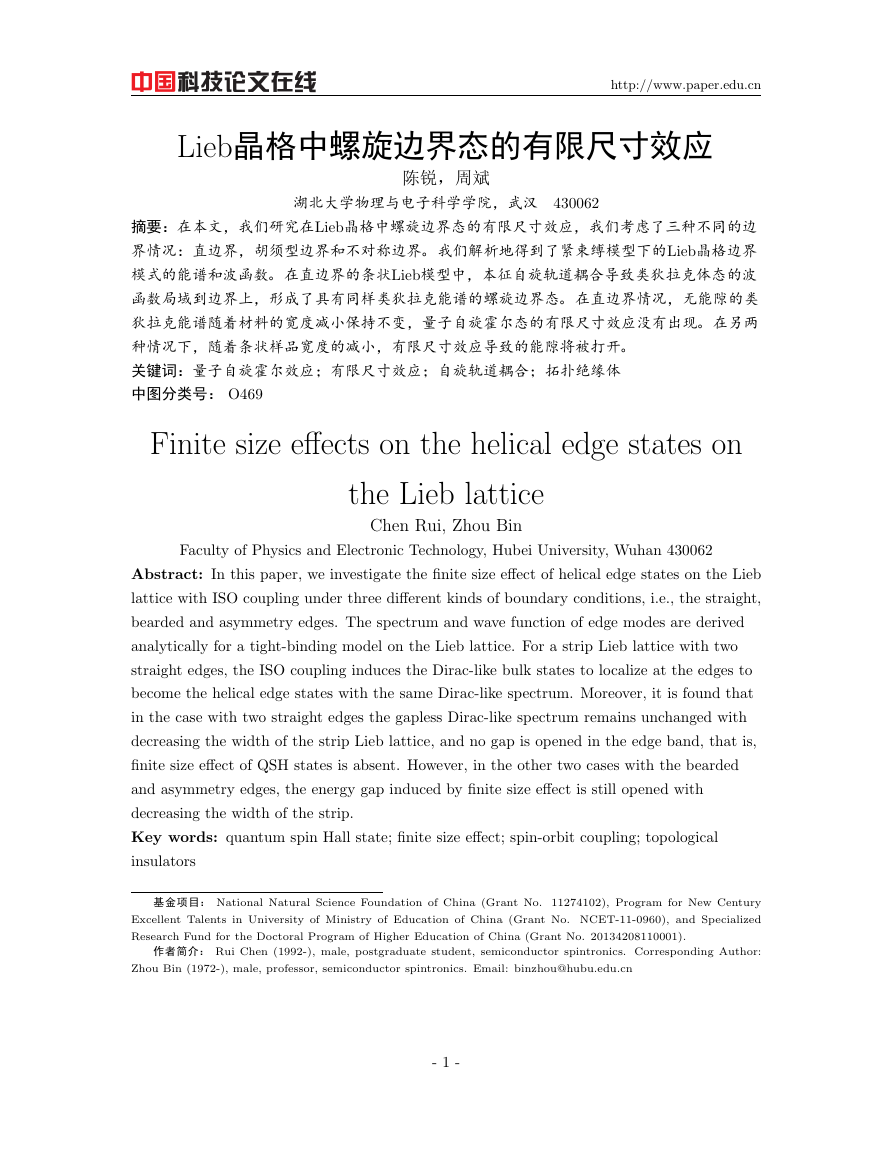
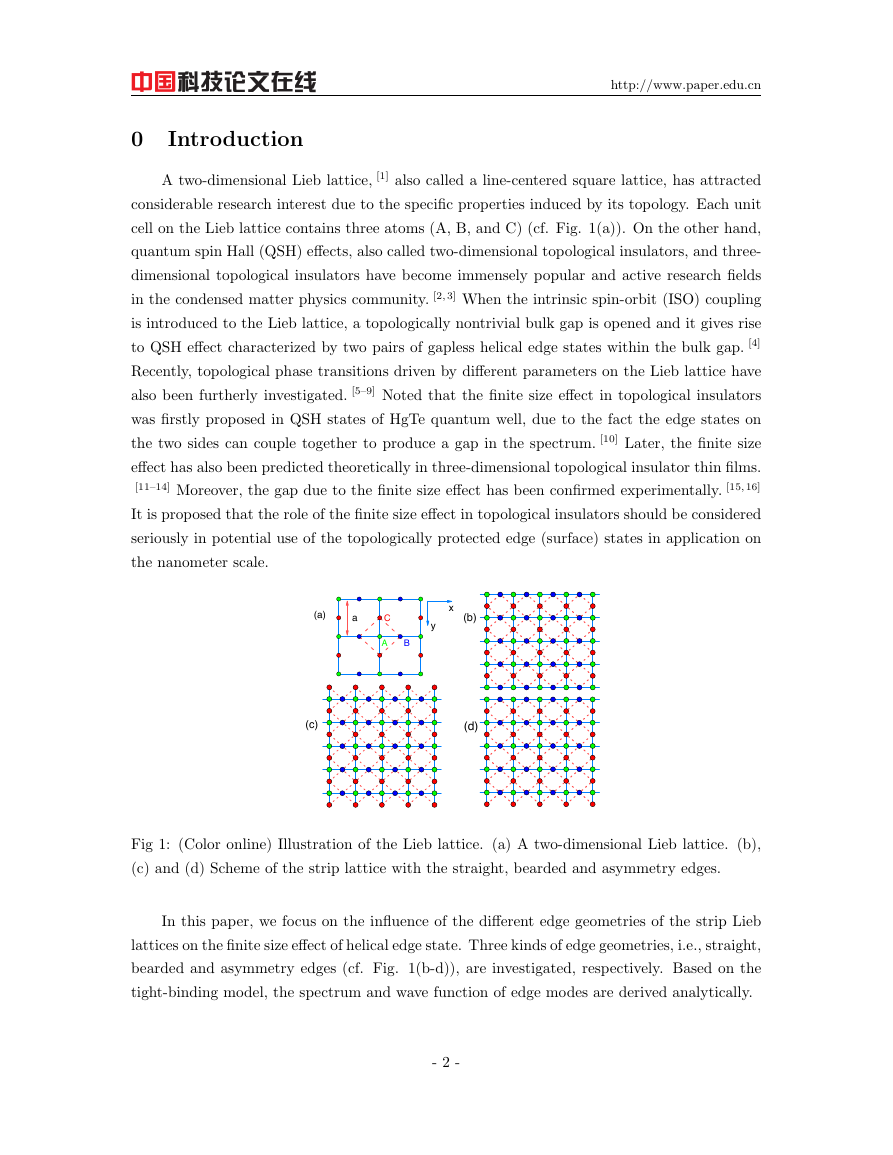
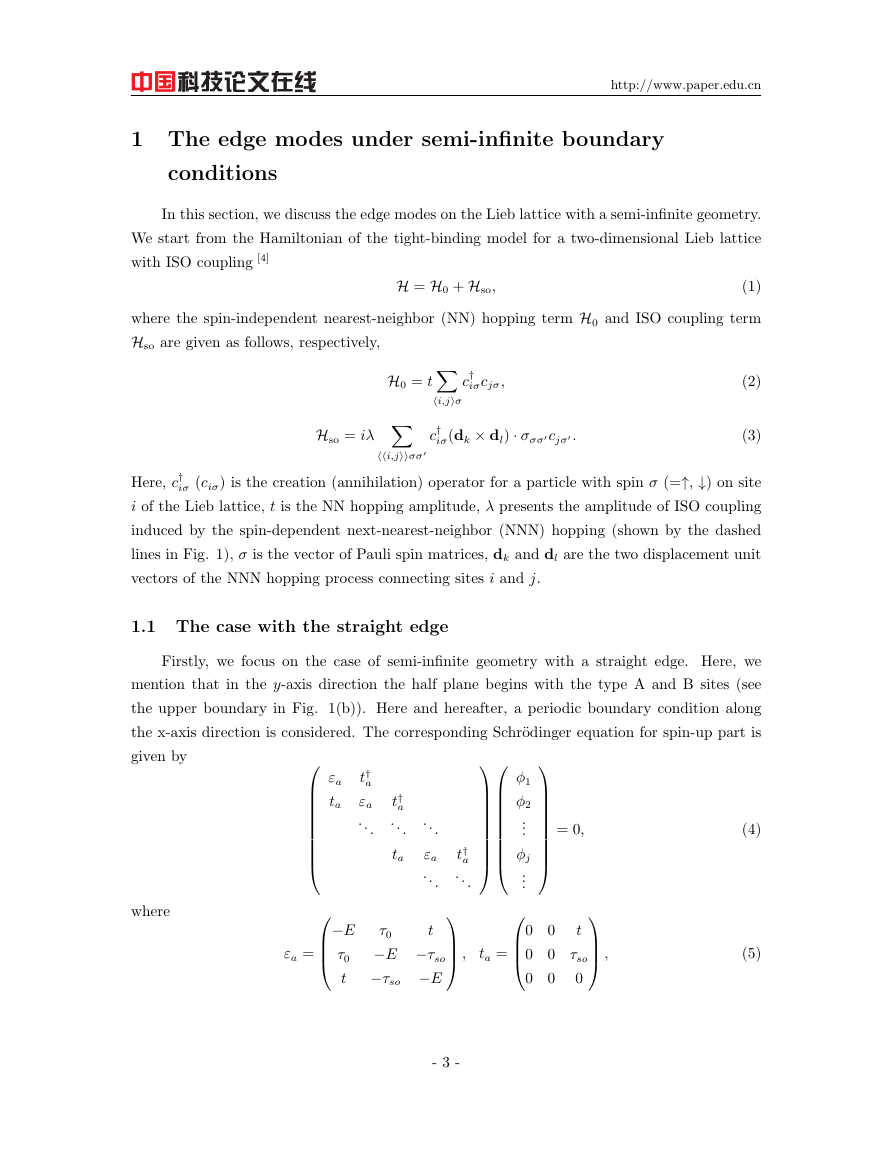
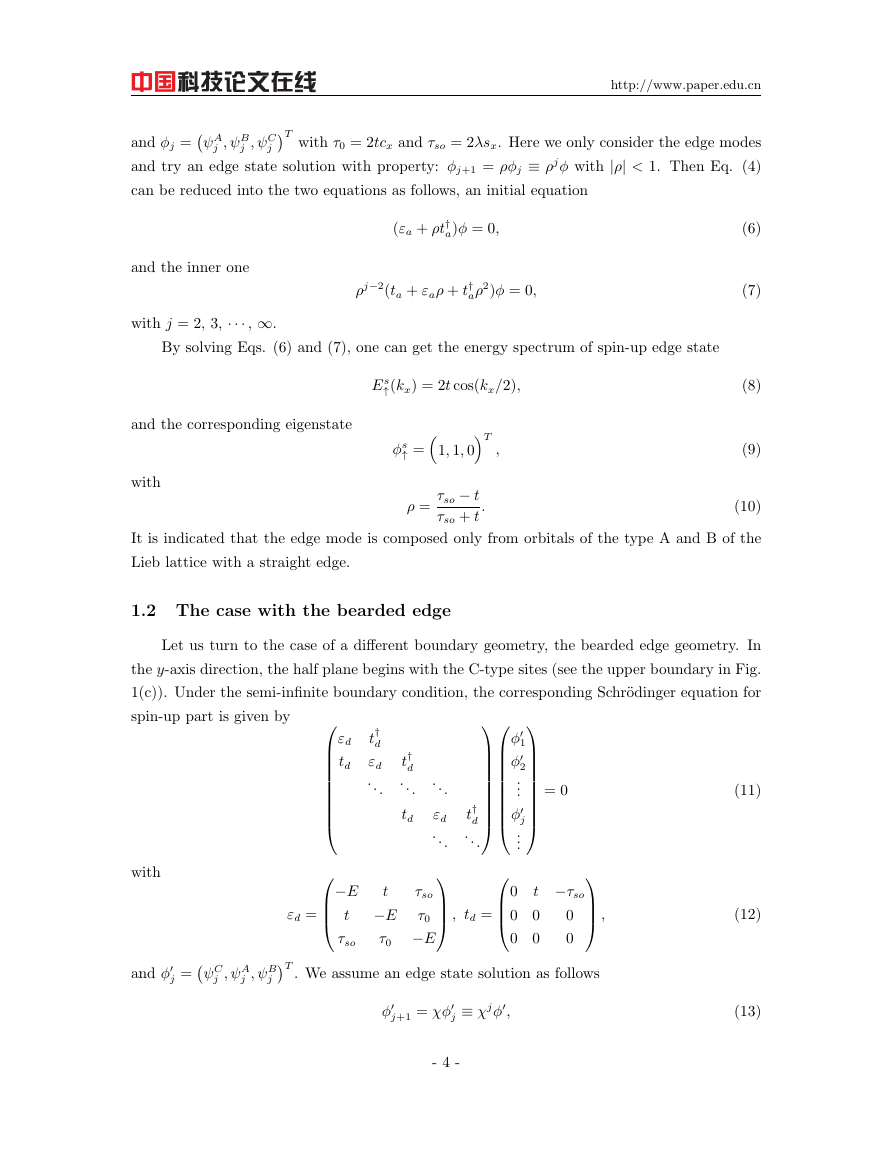
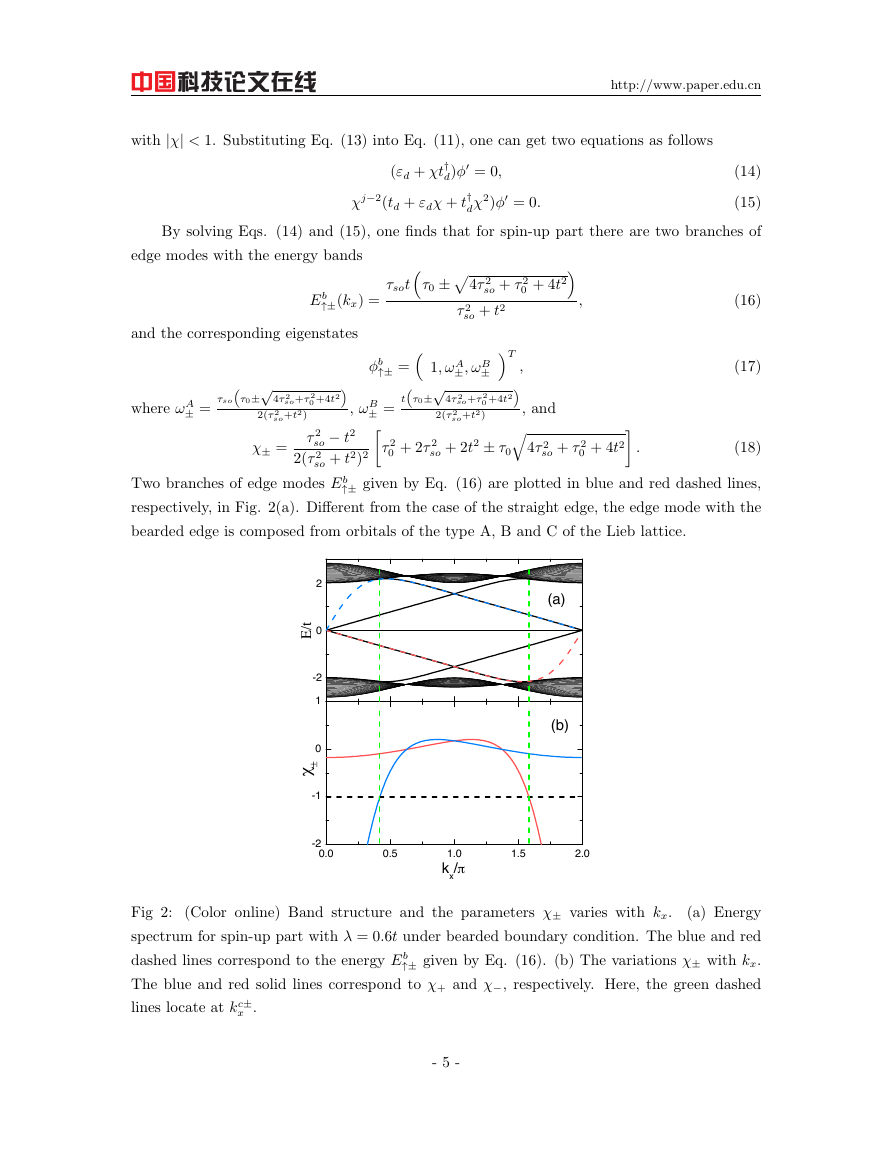
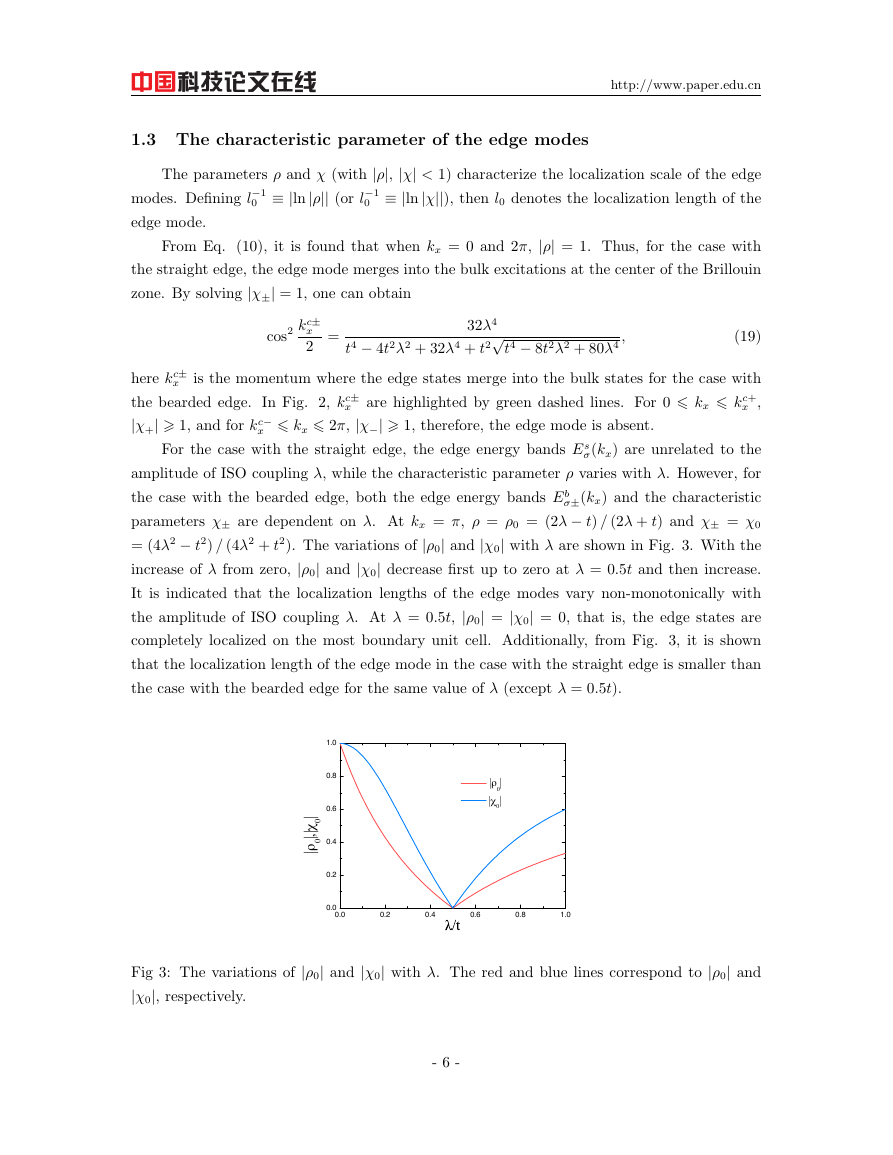
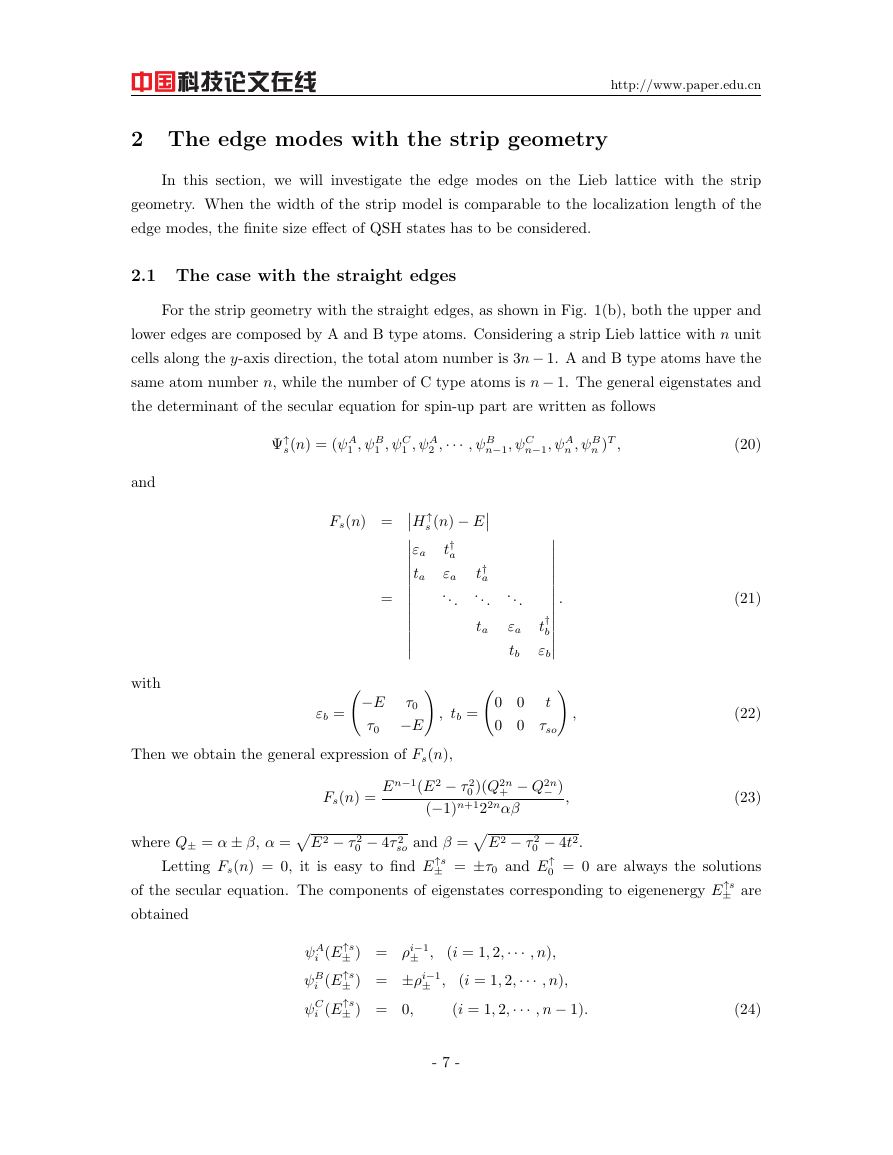









 2023年江西萍乡中考道德与法治真题及答案.doc
2023年江西萍乡中考道德与法治真题及答案.doc 2012年重庆南川中考生物真题及答案.doc
2012年重庆南川中考生物真题及答案.doc 2013年江西师范大学地理学综合及文艺理论基础考研真题.doc
2013年江西师范大学地理学综合及文艺理论基础考研真题.doc 2020年四川甘孜小升初语文真题及答案I卷.doc
2020年四川甘孜小升初语文真题及答案I卷.doc 2020年注册岩土工程师专业基础考试真题及答案.doc
2020年注册岩土工程师专业基础考试真题及答案.doc 2023-2024学年福建省厦门市九年级上学期数学月考试题及答案.doc
2023-2024学年福建省厦门市九年级上学期数学月考试题及答案.doc 2021-2022学年辽宁省沈阳市大东区九年级上学期语文期末试题及答案.doc
2021-2022学年辽宁省沈阳市大东区九年级上学期语文期末试题及答案.doc 2022-2023学年北京东城区初三第一学期物理期末试卷及答案.doc
2022-2023学年北京东城区初三第一学期物理期末试卷及答案.doc 2018上半年江西教师资格初中地理学科知识与教学能力真题及答案.doc
2018上半年江西教师资格初中地理学科知识与教学能力真题及答案.doc 2012年河北国家公务员申论考试真题及答案-省级.doc
2012年河北国家公务员申论考试真题及答案-省级.doc 2020-2021学年江苏省扬州市江都区邵樊片九年级上学期数学第一次质量检测试题及答案.doc
2020-2021学年江苏省扬州市江都区邵樊片九年级上学期数学第一次质量检测试题及答案.doc 2022下半年黑龙江教师资格证中学综合素质真题及答案.doc
2022下半年黑龙江教师资格证中学综合素质真题及答案.doc